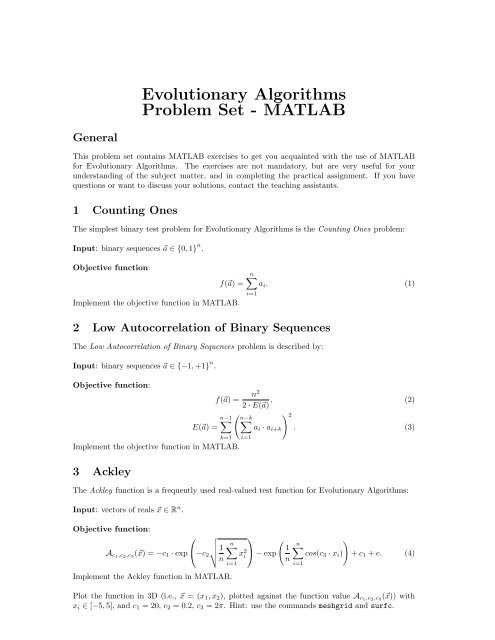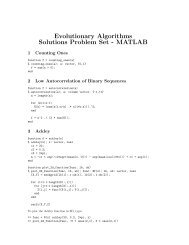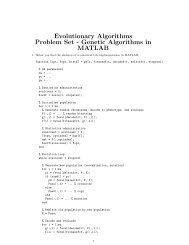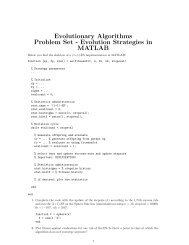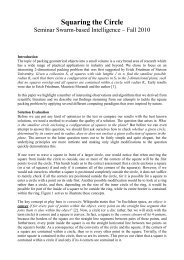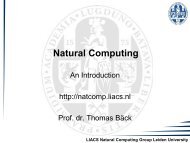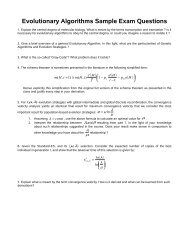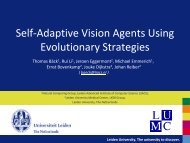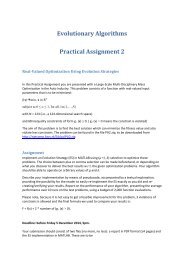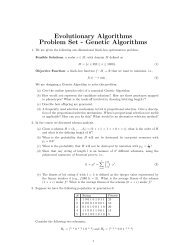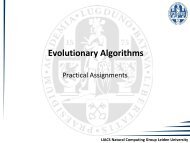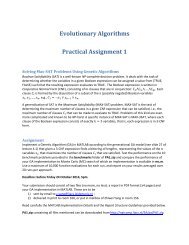Evolutionary Algorithms Problem Set - MATLAB
Evolutionary Algorithms Problem Set - MATLAB
Evolutionary Algorithms Problem Set - MATLAB
You also want an ePaper? Increase the reach of your titles
YUMPU automatically turns print PDFs into web optimized ePapers that Google loves.
<strong>Evolutionary</strong> <strong>Algorithms</strong><br />
<strong>Problem</strong> <strong>Set</strong> - <strong>MATLAB</strong><br />
General<br />
This problem set contains <strong>MATLAB</strong> exercises to get you acquainted with the use of <strong>MATLAB</strong><br />
for <strong>Evolutionary</strong> <strong>Algorithms</strong>. The exercises are not mandatory, but are very useful for your<br />
understanding of the subject matter, and in completing the practical assignment. If you have<br />
questions or want to discuss your solutions, contact the teaching assistants.<br />
1 Counting Ones<br />
The simplest binary test problem for <strong>Evolutionary</strong> <strong>Algorithms</strong> is the Counting Ones problem:<br />
Input: binary sequences ⃗a ∈ {0, 1} n .<br />
Objective function:<br />
f(⃗a) =<br />
Implement the objective function in <strong>MATLAB</strong>.<br />
2 Low Autocorrelation of Binary Sequences<br />
The Low Autocorrelation of Binary Sequences problem is described by:<br />
Input: binary sequences ⃗a ∈ {−1, +1} n .<br />
Objective function:<br />
n∑<br />
a i . (1)<br />
i=1<br />
n2<br />
f(⃗a) =<br />
2 · E(⃗a) , (2)<br />
(<br />
n−1<br />
∑ n−k<br />
) 2<br />
∑<br />
E(⃗a) = a i · a i+k .<br />
i=1<br />
(3)<br />
k=1<br />
Implement the objective function in <strong>MATLAB</strong>.<br />
3 Ackley<br />
The Ackley function is a frequently used real-valued test function for <strong>Evolutionary</strong> <strong>Algorithms</strong>:<br />
Input: vectors of reals ⃗x ∈ R n .<br />
Objective function:<br />
A c1,c 2,c 3<br />
(⃗x) = −c 1 · exp<br />
⎛<br />
⎝−c 2<br />
√ √√√<br />
1<br />
n<br />
Implement the Ackley function in <strong>MATLAB</strong>.<br />
n∑<br />
i=1<br />
x 2 i<br />
⎞<br />
⎠ − exp<br />
(<br />
1<br />
n<br />
)<br />
n∑<br />
cos(c 3 · x i ) + c 1 + e. (4)<br />
Plot the function in 3D (i.e., ⃗x = (x 1 , x 2 ), plotted against the function value A c1,c 2,c 3<br />
(⃗x)) with<br />
x i ∈ [−5, 5], and c 1 = 20, c 2 = 0.2, c 3 = 2π. Hint: use the commands meshgrid and surfc.<br />
i=1
4 Fletcher and Powell<br />
The function after Fletcher and Powell, an example of a nonlinear parameter estimation problem,<br />
is described by:<br />
Input: vectors of reals ⃗x ∈ R n .<br />
Objective function:<br />
F A,B,⃗α (⃗x) =<br />
p i (A, B, ⃗α) =<br />
q i (A, B, ⃗x) =<br />
n∑<br />
(p i (A, B, ⃗α) − q i (A, B, ⃗x)) 2 , (5)<br />
i=1<br />
n∑<br />
(a ij · sin(α j ) + b ij · cos(α j )) , (6)<br />
j=1<br />
n∑<br />
(a ij · sin(x j ) + b ij · cos(x j )) , (7)<br />
j=1<br />
where A and B are n × n matrices (i.e., A and B contain n 2 elements a ij and b ij respectively)<br />
and A, B, and ⃗α consist of random real values.<br />
Implement this function in <strong>MATLAB</strong>, assuming A, B, ⃗α, and ⃗x are given as input.<br />
5 Monte-Carlo Search for Binary <strong>Problem</strong>s<br />
Implement a Monte-Carlo Search algorithm (see slide 14 of lecture 1) for maximization problems<br />
in <strong>MATLAB</strong>, in order to solve the Counting Ones problem. Let the function take the following<br />
arguments:<br />
• the objective function;<br />
• the length n of the bitstrings ⃗a;<br />
• the maximum number of fitness function evaluations.<br />
Let the function produce as outputs:<br />
• the best individual found by the algorithm;<br />
• the fitness of the best individual.<br />
Use n = 100 and for a run of 100 iterations, plot the fitness against the elapsed number of iterations.<br />
Hint: store the current best solution found so far, and compare fitness value of new solutions<br />
with this current best solution. Furthermore, you can pass a function as argument by putting the<br />
@-symbol before the function name (i.e., it is passed as function handle).<br />
6 Simple (1+1)-GA for Binary <strong>Problem</strong>s<br />
Implement the alternative method given in slide 18 of lecture 1 (this can be regarded as a simple<br />
(1+1)-GA) for solving the Counting Ones problem, using the same approach as with the Monte-<br />
Carlo Search algorithm of assignment 5.<br />
Use n = 100 and a mutation rate p = 1/n. For a run of 100 iterations, plot the fitness against the<br />
elapsed number of iterations. Is there a difference in performance compared to the Monte-Carlo<br />
Search algorithm?
7 Monte-Carlo Search for Real-Valued <strong>Problem</strong>s<br />
Implement a Monte-Carlo Search algorithm for real-valued minimization problems in <strong>MATLAB</strong>.<br />
Let the function take the following arguments:<br />
• the objective function;<br />
• the length n of the vector ⃗x;<br />
• a vector of length n containing the lower bounds of the search domain;<br />
• a vector of length n containing the upper bounds of the search domain;<br />
• the maximum number of fitness function evaluations.<br />
Let the function produce as outputs:<br />
• the best individual found by the algorithm;<br />
• the fitness of the best individual.<br />
Run the algorithm on the Ackley function for 100 iterations with n = 2, x i ∈ [−5, 5], and c 1 = 20,<br />
c 2 = 0.2, c 3 = 2π. Plot the fitness versus the number of iterations.<br />
Note: we are now optimizing a minimization problem.<br />
8 Simple (1+1)-EA for Real-Valued <strong>Problem</strong>s<br />
Think of a way of implementing the alternative method of assignment 6, now for dealing with<br />
real-valued optimization problems.


